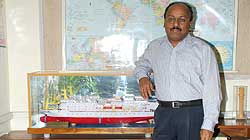There has been an impressive surge in traffic in the past few years. To cope with this, the policy of the Government is geared towards large-scale capacity addition. Your comments…
There is no doubt that traffic has been growing. The pace was slow in the past two years, following the global economic meltdown, but now the Indian economy is strong. While in 2008-09 we had a 2.1 per cent growth, between April 2009 and February 2010, the growth in traffic has been 5.5 per cent. Clearly traffic is growing. Ideally, capacity at ports should be about 30 per cent higher than traffic. In 2008-09, capacity utilization was of the tune of 93 per cent, which indicates there is need for a quick growth in capacity. The initial projections were that the capacity of Indian ports would reach 1.5 billion MTPA by March 2012. But a more realistic assessment now is that it will be about 1.25 billion MTPA, with two-thirds of this capacity in major ports, the rest in minor ports. We have concrete action plans for major ports. We’ve been witnessing considerable investor interest in the port projects.
There is enormous scope for private investment when it comes to capacity addition at the 12 major ports as mentioned in the document titled Emerging Investment Opportunities in Port Development…
During 2010-11, we’ve planned to award 21 projects with an overall outlay of Rs 14,000 crore. The number of projects and the corresponding outlay would be higher in 2011-12. Since port projects have a gestation of about two years, actually capacity created, though, will be available after the 11th Plan period.
|
During 2010-11, we’ve planned to award 21 projects with an overall outlay of Rs 14,000 crore. |

|
Also, as enumerated in the National Maritime Development Programme, there is scope for large-scale involvement of the Private Sector in areas such as berth development, deepening of channels, port connectivity projects, modernization / upgradation of cargo handling equipment…
When I say capacity addition, we include construction of terminals and mechanization. Deepening of channels is also part of capacity addition but cannot be strictly linked to the revenue stream. A PPP scenario is based on a revenue sharing model, so the bidding parameters give weightage to those who come up with the highest revenue-share model. Areas that do not have a revenue stream receive budgetary support or funds from the internal resources of the port.
As a policy, in order to increase India’s share in the global shipping industry, efforts are on to strengthen Indian shipping and ship building industry…
There is no doubt that tonnage under Indian flag vessels needs to be increased to make India a major player in the global shipping scenario. The Indian shipping industry, on its part, feels that some of the taxation / tax-related regulations are creating a situation where there is no level playing field for Indian ships vis-à-vis foreign ships. A large number of ships are flagged under liberal systems in Panama and Liberia. We would like to support the Indian shipping industry, the share of which in India’s global trade has fallen below 10 per cent from about 40 per cent two decades ago.
What steps are you envisaging in this direction?
We need to do a lot on coastal shipping where two things are under consideration. Firstly we need to move to shipping as a favoured mode of transport and encourage modal shift from land-based to water-based transport. Secondly, we need to ensure a bigger role for Indian ships in coastal traffic, going even to the extent of not allowing foreign ships to operate if Indian capacities are available. The Indian shipping industry tells us that many countries in the world, including the USA, follow strict monopolies when it comes to the plying of flagships of those countries, including for coastal trade.
What about ship building itself?
Overall, ship building needs to be supported because it is one of the activities with high potential in India. It is employment-oriented, needs steel as a major raw material, it has tremendous potential for ancillary development. We have witnessed the movements in ship building from Europe to Asia, where currently the leaders are Korea, Japan and China. There is no reason why India should not become a leading ship building country. But this needs quite a few policy interventions and financial support. To start with, we would probably be looking at a modest share of 5 per cent of the global ship building industry.
There is scope for increasing traffic on our national waterways. What steps are being taken in that direction?
Using the National Waterway is a priority area for us. The NW1 (1,620 km between Kolkata and Allahabad) is now ready for traffic. Development of jetties and other navigational areas are complete. We are talking of moving bulk cargo between Haldia and Farakka. River cruises are operating between Sadiya and Dhubri stretch of Brahmaputra, part of the NW2 (891 km). The Inland Waterways Authority of India is the infrastructure provider. The strategy is to talk to major handlers. Transportation over water is cheaper and safer, and has the ability to move much larger volumes in one trip than any form of land transport. One key development is that over-dimensional cargo will be moving between Kolkata and North East through Bangladesh.
Given the thrust in all directions that you’ve just mentioned, it would involve many more trained personnel than at present…
Absolutely, and that is why we have a full-fledged Maritime University in place now, headquartered and with a campus in Chennai, and with other campuses at Vishakhapatnam, Cochin, Kolkata, and Mumbai. Lots of training institutions have been brought under its ambit. New courses are being developed that would add to the conventional courses in nautical sciences, engineering, architecture and law. There are over 4,600 students, and our objective is to make it one of the top educational institutions of its kind in the world.
|